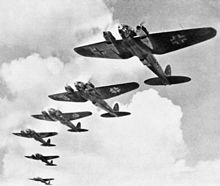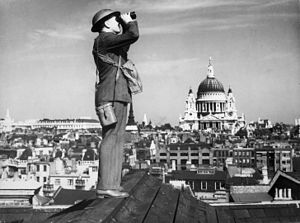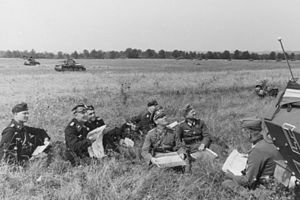
German troops advancing past abandoned American equipment
German leader Adolf Hitler felt that his mobile reserves allowed him to mount one major offensive. Although he realised nothing significant could be accomplished in the Eastern Front, he still believed an offensive against the Western Allies, whom he considered militarily inferior to the Red Army, would have some chances of success. Hitler believed he could split the Allied forces and compel the Americans and British to settle for a separate peace, independent of the Soviet Union. Success in the west would give the Germans time to design and produce more advanced weapons (such as jet aircraft, new U-boat designs and super-heavy tanks) and permit the concentration of forces in the east. After the war ended, this assessment was generally viewed as unrealistic, given Allied air superiority throughout Europe and their ability to continually disrupt German offensive operations.
Given the reduced manpower of their land forces at the time, the Germans believed the best way to seize the initiative would be to attack in the West against the smaller Allied forces rather than against the vast Soviet armies. Even theencirclement and destruction of entire Soviet armies, an unlikely outcome, would still have left the Soviets with a numerical superiority.
Several senior German military officers, including Field Marshal Walter Model and von Rundstedt, expressed concern as to whether the goals of the offensive could be realized. They offered alternative plans, but Hitler would not listen. The plan banked on unfavorable weather, including heavy fog and low-lying clouds, which would minimize the Allied air advantage. Hitler originally set the offensive for late November, before the anticipated start of the Russian winter offensive.

The U.S. 82nd Airborne Div. dropping on Grave, during Operation Market Garden.
In the west supply problems began significantly to impede Allied operations, even though the opening of the port of Antwerp in late November improved the situation somewhat. The positions of the Allied armies stretched from southern France all the way north to the Netherlands. German planning for the counteroffensive rested on the premise that a successful strike against thinly-manned stretches of the line would halt Allied advances on the entire Western Front.
Several plans for major Western offensives were put forward, but Oberkommando der Wehrmacht (High Command of the Armed Forces, or OKW) quickly concentrated on two. A first plan for an encirclement maneuver called for a two-pronged attack along the borders of the U.S. forces around Aachen, hoping to encircle the U.S. Ninth Army and leave the German forces again in control of the excellent defensive grounds where they had fought the U.S. to a standstill just weeks before. A second plan called for a classic blitzkrieg attack through the weakly defended Ardennes Mountains—mirroring the successful German offensive there during the Battle of France in 1940—aimed at splitting the armies along the U.S.—British lines and capturing Antwerp.
Hitler chose the second plan, believing a successful encirclement would have little impact on the overall situation and finding the prospect of splitting the Anglo-American armies more appealing. The disputes between Montgomery and Patton were well known, and Hitler hoped he could exploit this perceived disunity. If the attack were to succeed in capturing Antwerp, four complete armies would be trapped without supplies behind German lines.
Both plans centered on attacks against the American forces. Hitler believed the Americans were incapable of fighting effectively, and that the American home front was likely to crack upon hearing of a decisive American loss.
Tasked with carrying out the operation were Generalfeldmarschall (Field Marshal) Walther Model, the commander of German Army Group B (Heeresgruppe B), and Field MarshalGerd von Rundstedt, the overall commander of the German Army Command in the West (Oberbefehlshaber West), who had moved his base of operations to Kransberg Castle.
Model and von Rundstedt both believed aiming for Antwerp was too ambitious, given Germany’s scarce resources in late 1944. At the same time they felt that maintaining a purely defensive posture (as had been the case since Normandy) would only delay defeat, not avert it. They thus developed alternative, less ambitious plans that did not aim to cross theMeuse River; Model’s being Unternehmen Herbstnebel (Operation Autumn Mist) and von Rundstedt’s Fall Martin (“Plan Martin”). The two field marshals combined their plans to present a joint “small solution” to Hitler, who rejected it in favor of his “big solution”.
OKW decided by mid-September, at Hitler’s insistence, that the offensive would be mounted in the Ardennes, as was done in 1940. Many German generals objected, but the offensive was planned and carried out anyway. In 1940 German forces had passed through the Ardennes in three days before engaging the enemy, but the 1944 plan called for battle in the forest itself. The main forces were to advance westward to the Meuse River, then turn northwest for Antwerp and Brussels. The close terrain of the Ardennes would make rapid movement difficult, though open ground beyond the Meuse offered the prospect of a successful dash to the coast.
Four armies were selected for the operation. First was the Sixth Panzer Army, under SS General Sepp Dietrich—newly created on 26 October 1944, it incorporated the most senior and the most experienced formation of the Waffen-SS: the 1st SS Panzer DivisionLeibstandarte Adolf Hitler as well as the 12th SS Panzer Division Hitlerjugend. The 6th Panzer Army was designated the northernmost attack force, having its northernmost point on the pre-attack battlefront nearest the German town of Monschau. It was entrusted with the offensive’s primary objective—capturing Antwerp.
The Fifth Panzer Army under General Hasso von Manteuffel was assigned to the middle attack route with the objective of capturing Brussels.
The Seventh Army, under General Erich Brandenberger, was assigned to the southernmost attack, having its southernmost point on the pre-attack battlefront nearest the Luxembourg town of Echternach, with the task of protecting the flank. This Army was made up of only four infantry divisions, with no large-scale armored formations to use as a spearhead unit. As a result, they made little progress throughout the battle.
Also participating in a secondary role was the Fifteenth Army, under General Gustav-Adolf von Zangen. Recently brought back up to strength and re-equipped after heavy fighting during Market Garden, it was located on the far north of the Ardennes battlefield and tasked with holding U.S. forces in place, with the possibility of launching its own attack given favorable conditions.
For the offensive to be successful, four criteria were deemed critical: the attack had to be a complete surprise; the weather conditions had to be poor to neutralize Allied air superiority and the damage it could inflict on the German offensive and its supply lines; the progress had to be rapid—-the Meuse River, halfway to Antwerp, had to be reached by day 4; and Allied fuel supplies would have to be captured intact along the way because the Wehrmacht was short on fuel. The General Staff estimated they only had enough fuel to cover one-third to one-half of the ground to Antwerp in heavy combat conditions.
The plan originally called for just under 45 divisions, including a dozen panzer and panzergrenadierdivisions forming the armored spearhead and various infantry units to form a defensive line as the battle unfolded. By this time, however, the German Army suffered from an acute manpower shortage and the force had been reduced to around 30 divisions. Although it retained most of its armor, there were not enough infantry units because of the defensive needs in the East. These 30 newly rebuilt divisions used some of the last reserves of the German Army. Among them were Volksgrenadier units formed from a mix of battle-hardened veterans and recruits formerly regarded as too young or too old to fight. Training time, equipment and supplies were inadequate during the preparations. German fuel supplies were precarious—those materials and supplies that could not be directly transported by rail had to be horse-drawn to conserve fuel, and the mechanized and panzer divisions would depend heavily on captured fuel. As a result, the start of the offensive was delayed from 27 November to 16 December.
Before the offensive the Allies were virtually blind to German troop movement. During the liberation of France, the extensive network of the French resistance had provided valuable intelligence about German dispositions. Once they reached the German border, this source dried up. In France, orders had been relayed within the German army using radio messages enciphered by the Enigma machine, and these could be picked up and decrypted by Allied code-breakers headquartered at Bletchley Park, to give the intelligence known as ULTRA. In Germany such orders were typically transmitted using telephone and teleprinter, and a special radio silence order was imposed on all matters concerning the upcoming offensive. The major crackdown in the Wehrmacht after the 20 July plot to assassinate Hitler resulted in much tighter security and fewer leaks. The foggy autumn weather also prevented Allied reconnaissance aircraft from correctly assessing the ground situation. German units assembling in the area were even issued charcoal instead of wood for cooking fires to cut down on smoke and reduce chances of Allied observers deducing a troop build up was underway.
For these reasons Allied High Command considered the Ardennes a quiet sector, relying on assessments from their intelligence services that the Germans were unable to launch any major offensive operations this late in the war. What little intelligence they had led the Allies to believe precisely what the Germans wanted them to believe-–that preparations were being carried out only for defensive, not offensive, operations. In fact, because of the Germans’ efforts, the Allies were led to believe that a new defensive army was being formed around Düsseldorf in the northern Rhine, possibly to defend against British attack. This was done by increasing the number of flak batteries in the area and the artificial multiplication of radio transmissions in the area. The Allies at this point thought the information was of no importance. All of this meant that the attack, when it came, completely surprised the Allied forces. Remarkably, the U.S. Third Army intelligence chief, Colonel Oscar Koch, the U.S. First Army intelligence chief and the SHAEF intelligence officer all correctly predicted the German offensive capability and intention to strike the U.S. VIII Corps area. These predictions were largely dismissed by the U.S. 12th Army Group. Historian Patrick K. O’Donnell writes that on 8 December 1944, U.S. Rangers at great cost took Hill 400 during the Battle of the Hürtgen Forest. The next day GIs who relieved the Rangers reported a considerable movement of German troops inside the Ardennes in the enemy’s rear, but that no one in the chain of command connected the dots.
Because the Ardennes was considered a quiet sector, economy-of-force considerations led it to be used as a training ground for new units and a rest area for units that had seen hard fighting. The U.S. units deployed in the Ardennes thus were a mixture of inexperienced troops (such as the raw U.S. 99th and 106th “Golden Lions” Divisions), and battle-hardened troops sent to that sector to recuperate (the 28th Infantry Division).
Two major special operations were planned for the offensive. By October it was decided that Otto Skorzeny, the German commando who had rescued the former Italian dictatorBenito Mussolini, was to lead a task force of English-speaking German soldiers in “Operation Greif”. These soldiers were to be dressed in American and British uniforms and weardog tags taken from corpses and POWs. Their job was to go behind American lines and change signposts, misdirect traffic, generally cause disruption and seize bridges across the Meuse River between Liège and Namur. By late November, another ambitious special operation was added: Col. Friedrich August von der Heydte was to lead a Fallschirmjäger(paratrooper) Kampfgruppe in Operation Stösser, a night-time paratroop drop behind the Allied lines aimed at capturing a vital road junction near Malmedy.
German intelligence had set 20 December as the expected date for the start of the upcoming Soviet offensive, aimed at crushing what was left of German resistance on the Eastern Front and thereby opening the way to Berlin. It was hoped that Soviet leader Stalin would delay the start of the operation once the German assault in the Ardennes had begun and wait for the outcome before continuing.
After the 20 July plot attempt on Hitler’s life, and the close advance of the Red Army, Hitler and his staff had been forced to abandon the Wolfsschanze headquarters in East Prussia, in which they had coordinated much of the fighting on the Eastern Front. After a brief visit to Berlin, Hitler travelled on his Führersonderzug (train) to Giessen on 11 December, taking up residence in the Adlerhorst command complex, co-located with OB West’s base at Kransberg Castle. Believing in omens and the successes of his early war campaigns that had been planned at Kransberg, Hitler had chosen the site from which he had overseen the successful 1940 campaign against France and the Low Countries.
Von Rundstedt set up his operational headquarters near Limburg, close enough for the generals and Panzer Corps commanders who were to lead the attack to visit Adlerhorst on 11 December, travelling there in an SS-operated bus convoy. With the castle acting as overflow accommodation, the main party was settled into the Adlerhorst’s Haus 2 command bunker, including Gen. Alfred Jodl, Gen. Wilhelm Keitel, Gen. Blumentritt, von Manteuffel and S.S. Gen. Sepp Dietrich. Von Rundstedt then ran through the battle plan, while Hitler made one of his stoic speeches.
In a personal conversation on 13 December between Walther Model and Friedrich von der Heydte, who was put in charge of Operation Stösser, von der Heydte gave OperationStösser less than a 10% chance of succeeding. Model told him it was necessary to make the attempt: “It must be done because this offensive is the last chance to conclude the war favorably.”
Initial German assault

Situation on the Western Front as of 15 December 1944
On 16 December 1944, at 05:30, the Germans began the assault with a massive, 90-minute artillery barrage using 1,600 artillery pieces across a 130-kilometre (80 mi) front on the Allied troops facing the 6th Panzer Army. The Americans’ initial impression was that this was the anticipated, localized counterattack resulting from the Allies’ recent attack in the Wahlerscheid sector to the north, where the 2nd Division had knocked a sizable dent in the Siegfried Line. In the northern sector Dietrich’s 6th Panzer Army was held up for almost 24 hours by a single reconnaissance platoon and four U.S. Forward Artillery Observers dug in on a ridge overlooking a key road intersection in the village of Lanzerath. They then assaulted Losheim Gap and Elsenborn Ridge in an effort to break through to Liège and Antwerp.
Heavy snowstorms engulfed parts of the Ardennes area. While having the desired effect of keeping the Allied aircraft grounded, the weather also proved troublesome for the Germans because poor road conditions hampered their advance. Poor traffic control led to massive traffic jams and fuel shortages in forward units.
In the center, von Manteuffel’s Fifth Panzer Army attacked towards Bastogne and St. Vith, both road junctions of great strategic importance. In the south, Brandenberger’s Seventh Army pushed towards Luxembourg in its efforts to secure the flank from Allied attacks. Only one month before 250 members of the Waffen-SS had unsuccessfully tried to recapture the town of Vianden with its castle from the Luxembourgish resistance during the Battle of Vianden.
source : wikipedia















